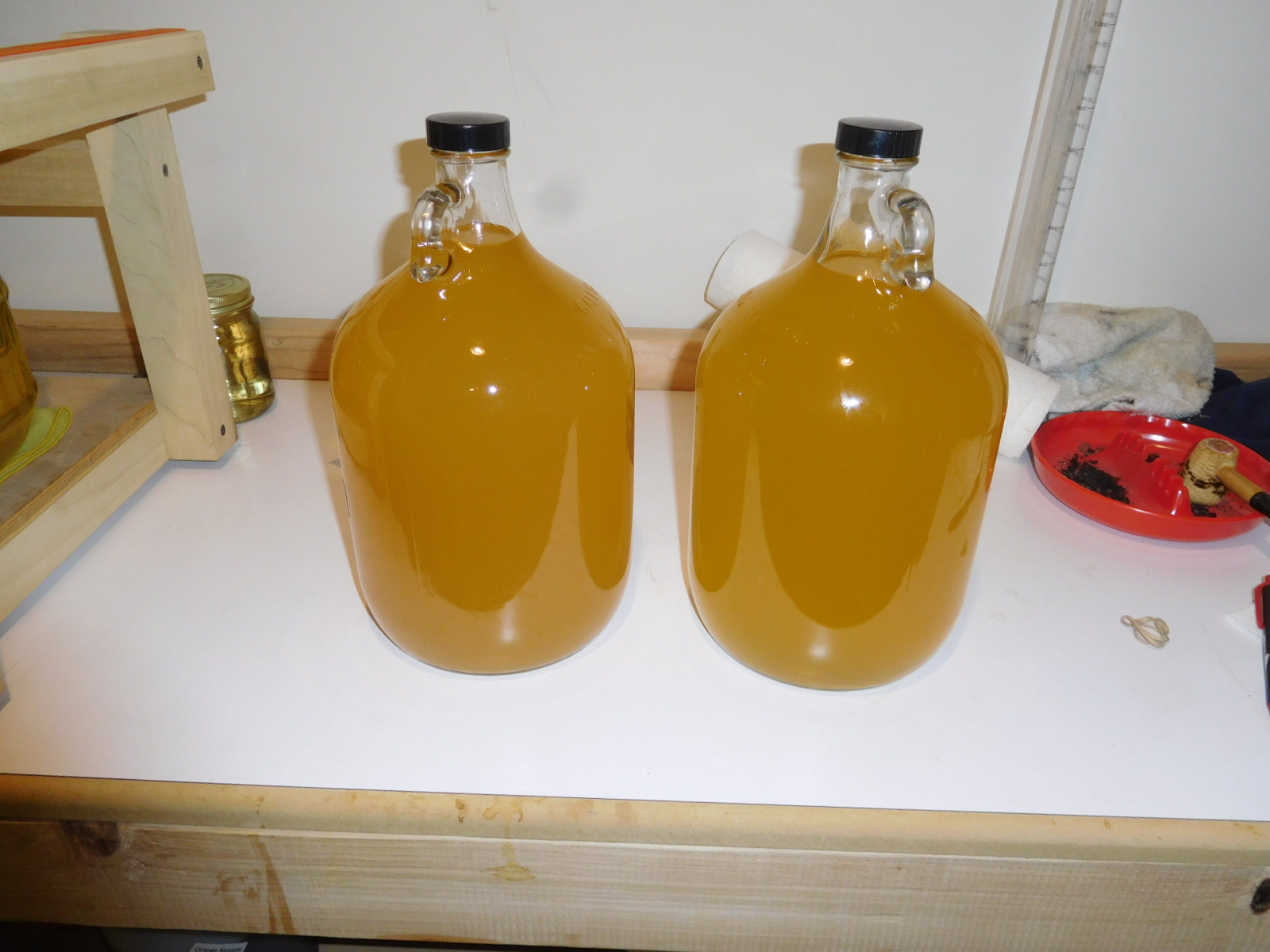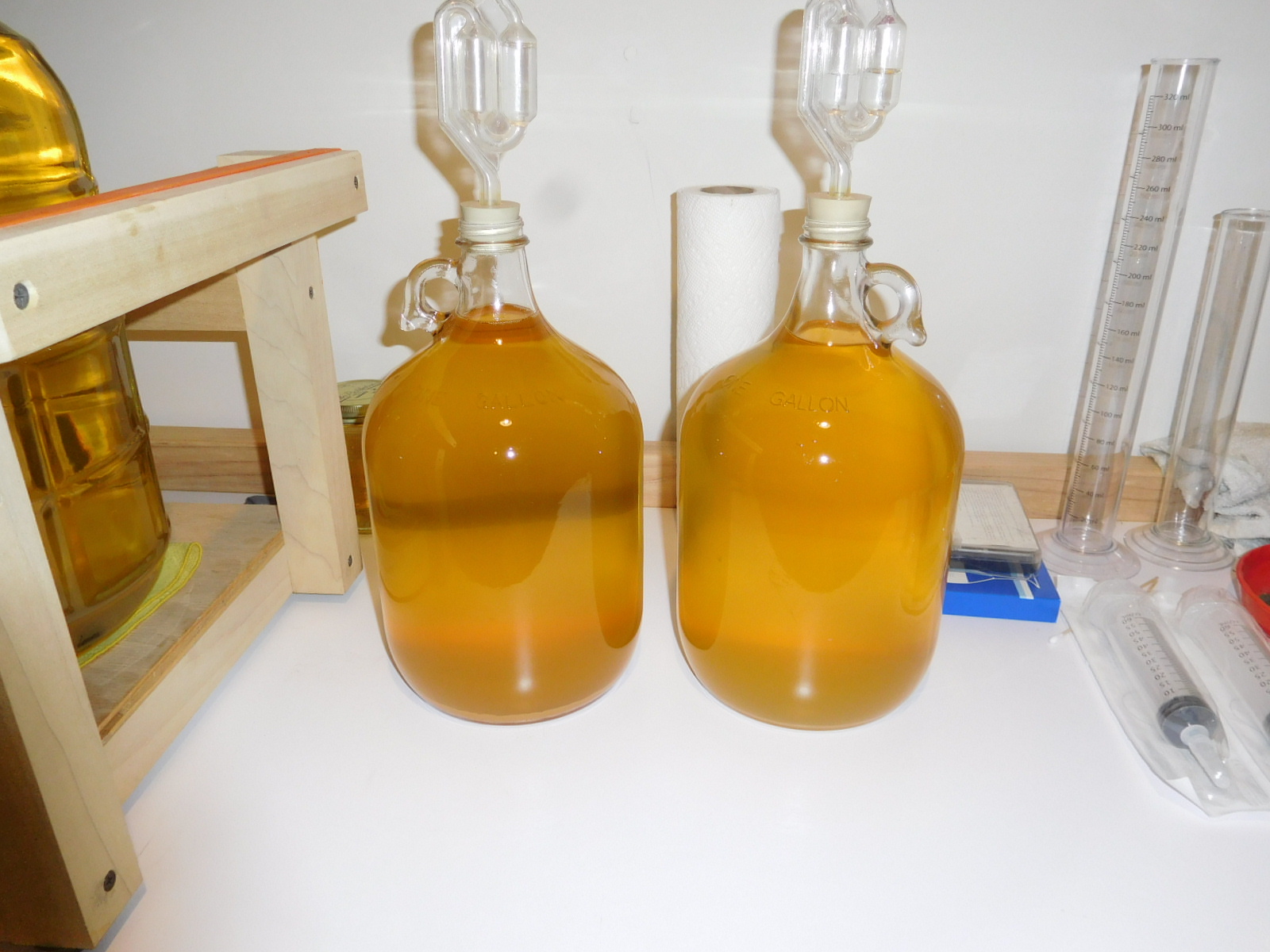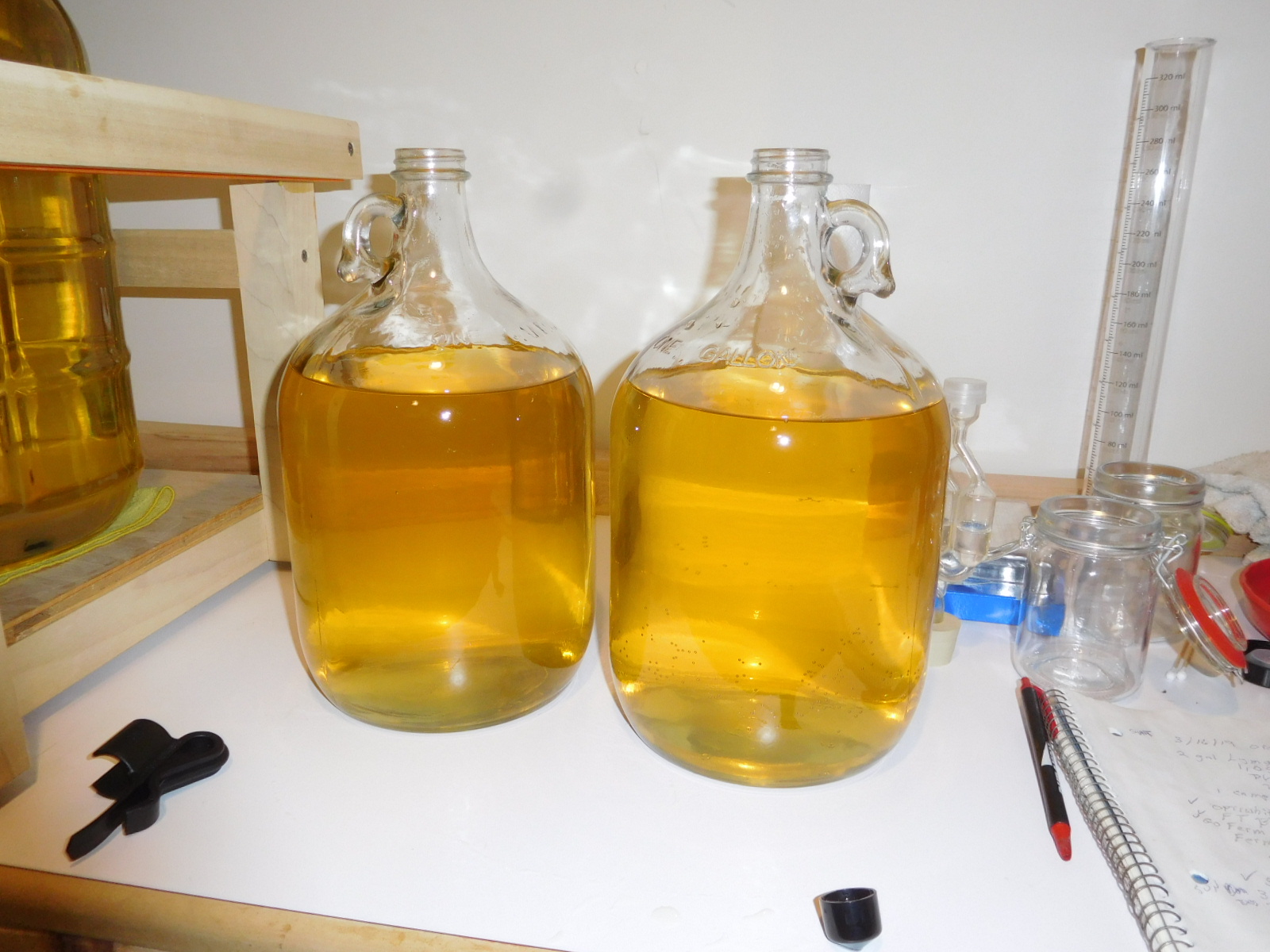Dirty mead tastes dirty. Plan your batch size to anticipate rackings.
You are using an out of date browser. It may not display this or other websites correctly.
You should upgrade or use an alternative browser.
You should upgrade or use an alternative browser.
boil bentonite?
- Thread starter NeverDie
- Start date

Help Support Homebrew Talk:
This site may earn a commission from merchant affiliate
links, including eBay, Amazon, and others.
NeverDie
Well-Known Member
I think what I need is a tall, but narrowish tube (almost like a graduated cylinder) to better help with racking. That way, after settling, the bentonite can be kept far away, for as long as possible, from the siphon tube, and thereby minimize waste as well as the drips and drabs. Seems like that might work the best. A typical carboy is just too wide for racking purposes to have a great yield.
NeverDie
Well-Known Member
OK, so I just now ordered a 2000ml cylinder: https://www.amazon.com/gp/product/B006UKIBKU/ref=ppx_od_dt_b_asin_title_s00?ie=UTF8&psc=1
and I notice that the very first of the amazon comments was that the guy uses it to decant yeast from his fermenter. So, he had essentially the same general idea.
So, he had essentially the same general idea.
There also exist 4000ml cylinders, but they're much pricier.
and I notice that the very first of the amazon comments was that the guy uses it to decant yeast from his fermenter.
There also exist 4000ml cylinders, but they're much pricier.
Last edited:
Maybe with small batches bentonite is a poor choice. Someone already mentioned that the sediment from SuperKleer is a lot less than with bentonite, and that racking losses are therefore less. Unfortunately, it's somewhat expensive and the non resealable packs are sized for 5 gallons. I've used it by measuring out the dose with a syringe but I have no way to store the remainder.
There's also Sparkalloid, which I've never used but gets good reviews. Maybe someone can comment on what the sediment is with that.
What works for me is to make a bigger batch than what I want with the anticipation of having to rack a couple times and suffer with the losses. This 2 gallon cyser started as 2 gallons plus about a quart of honey and racked to 2 one gallon jugs. From there it'll get racked (and maybe fined) again and the headspace will accommodate backsweetening honey and oak cubes.
There's also Sparkalloid, which I've never used but gets good reviews. Maybe someone can comment on what the sediment is with that.
What works for me is to make a bigger batch than what I want with the anticipation of having to rack a couple times and suffer with the losses. This 2 gallon cyser started as 2 gallons plus about a quart of honey and racked to 2 one gallon jugs. From there it'll get racked (and maybe fined) again and the headspace will accommodate backsweetening honey and oak cubes.
NeverDie
Well-Known Member
Speaking of the fresco cyser, I racked it off the bentonite this morning and tried it. I like it, but I agree some oak would make it better. So, I'm going to toss some cubes in and see what happens.

$7.79 ($7.79 / Count)
Craft A Brew - LalBrew Voss™ - Kveik Ale Yeast - For Craft Lagers - Ingredients for Home Brewing - Beer Making Supplies - (1 Pack)
Craft a Brew

$10.99 ($31.16 / Ounce)
Hornindal Kveik Yeast for Homebrewing - Mead, Cider, Wine, Beer - 10g Packet - Saccharomyces Cerevisiae - Sold by Shadowhive.com
Shadowhive

$58.16
HUIZHUGS Brewing Equipment Keg Ball Lock Faucet 30cm Reinforced Silicone Hose Secondary Fermentation Homebrew Kegging Brewing Equipment
xiangshuizhenzhanglingfengshop

$479.00
$559.00
EdgeStar KC1000SS Craft Brew Kegerator for 1/6 Barrel and Cornelius Kegs
Amazon.com

$22.00 ($623.23 / Ounce)
AMZLMPKNTW Ball Lock Sample Faucet 30cm Reinforced Silicone Hose Secondary Fermentation Homebrew Kegging joyful
无为中南商贸有限公司

$33.99 ($17.00 / Count)
$41.99 ($21.00 / Count)
2 Pack 1 Gallon Large Fermentation Jars with 3 Airlocks and 2 SCREW Lids(100% Airtight Heavy Duty Lid w Silicone) - Wide Mouth Glass Jars w Scale Mark - Pickle Jars for Sauerkraut, Sourdough Starter
Qianfenie Direct

$53.24
1pc Hose Barb/MFL 1.5" Tri Clamp to Ball Lock Post Liquid Gas Homebrew Kegging Fermentation Parts Brewer Hardware SUS304(Gas MFL)
yunchengshiyanhuqucuichendianzishangwuyouxiangongsi

$28.98
Five Star - 6022b_ - Star San - 32 Ounce - High Foaming Sanitizer
Great Fermentations of Indiana
![Craft A Brew - Safale S-04 Dry Yeast - Fermentis - English Ale Dry Yeast - For English and American Ales and Hard Apple Ciders - Ingredients for Home Brewing - Beer Making Supplies - [1 Pack]](https://m.media-amazon.com/images/I/41fVGNh6JfL._SL500_.jpg)
$6.95 ($17.38 / Ounce)
$7.47 ($18.68 / Ounce)
Craft A Brew - Safale S-04 Dry Yeast - Fermentis - English Ale Dry Yeast - For English and American Ales and Hard Apple Ciders - Ingredients for Home Brewing - Beer Making Supplies - [1 Pack]
Hobby Homebrew

$20.94
$29.99
The Brew Your Own Big Book of Clone Recipes: Featuring 300 Homebrew Recipes from Your Favorite Breweries
Amazon.com

$176.97
1pc Commercial Keg Manifold 2" Tri Clamp,Ball Lock Tapping Head,Pressure Gauge/Adjustable PRV for Kegging,Fermentation Control
hanhanbaihuoxiaoshoudian

$53.24
1pc Hose Barb/MFL 1.5" Tri Clamp to Ball Lock Post Liquid Gas Homebrew Kegging Fermentation Parts Brewer Hardware SUS304(Gas MFL)
Guangshui Weilu You Trading Co., Ltd
- Joined
- Jun 2, 2008
- Messages
- 64,955
- Reaction score
- 16,524
Reporting back: Because of this I did try the Chemex coffee filter, and it did in fact remove small drips and drabs of bentonite to produce an ultra clear final racking. It is not, however, good for filtering true sludge or anything even close to that, at least not in a single pass. The more sludgy the mead from bentonite, the more diminishing returns quickly become a limiting factor, with lower yields because of more rackings and filterings required to clean it up.
So, at least to me, bentonite (and probably fining in general) is a tool of last resort. If I can find a yeast strain that both tastes good and doesn't require it, then that would be preferable. If I can't find such a unicorn, then I'll have to make bigger batches to offset the lower yields, or else become more accepting of haze/cloudiness, as does exist in even some commercial meads.
Conclusion: when it comes to personal consumption, I'll take the haze rather than the hassle. When it comes to making a mead for friends to comfortably enjoy without worries or reservations, I think that's when bentonite or similar makes sense. Otherwise it can tend to look a bit dodgy, especially to someone unfamiliar with mead or homebrewing.
Even with bentonite, fining takes time.
It's not going to be completely settled and compacted after 24 hours.
NeverDie
Well-Known Member
Even with bentonite, fining takes time.
It's not going to be completely settled and compacted after 24 hours.
How long does it require? It's useful to put numbers on things.
Last edited:
NeverDie
Well-Known Member
Reporting back: Today I tried 1/2 TSP Bentonite across 5 different meads, and it just wasn't enough to clear them. The 1 TSP I tried previously worked great, and more or less instantly, so I guess that's about the right dosing per gallon.
I take it back. It turns out that after further agitation and a second cold crash, all 5 of them cleared on just 1/2 Tsp Bentonite per gallon. Less lees, and so less waste. More time and effort.
I'm considering trying that with my cyser. Or maybe another dose of pectic enzyme, the first one doesn't seem to have done much. I wish there was a way to tell what the haze is from - yeast, pectin, or honey proteins. That'd make choosing a fining easier.
NeverDie
Well-Known Member
I'm considering trying that with my cyser. Or maybe another dose of pectic enzyme, the first one doesn't seem to have done much. I wish there was a way to tell what the haze is from - yeast, pectin, or honey proteins. That'd make choosing a fining easier.
Maybe run small 10ml tests with different finings to see which is effective? I guess that wouldn't work with superKleer though if the leftover can't be stored.
At least Sparkaloid is powdered so it is easily divisible and you only use what's needed. Seems like it would be worth a try.
Last edited:
The SuperKleer IIRC is a 50 ml packet and a 15 ml packet that mixes with 30 ml of warm water. So if I had two 50 ml syringes I could store them that way and dose per gallon. I think I'm gonna do that. Or maybe save a couple pill bottles.
Before I decide, I'm gonna see what the cysers look like after a week in the fridge.
Before I decide, I'm gonna see what the cysers look like after a week in the fridge.
- Joined
- Jun 2, 2008
- Messages
- 64,955
- Reaction score
- 16,524
How long does it require? It's useful to put numbers on things.
Most sources seem to say several days....
NeverDie
Well-Known Member
The SuperKleer IIRC is a 50 ml packet and a 15 ml packet that mixes with 30 ml of warm water. So if I had two 50 ml syringes I could store them that way and dose per gallon. I think I'm gonna do that. Or maybe save a couple pill bottles.
Before I decide, I'm gonna see what the cysers look like after a week in the fridge.
Yeah, that or maybe save it in little 2ml cryogenic vials and then later pull out however many you need.
I played around today with a smaller graduated cylinder and the chemex coffee filter with improved results for racking off the bentonite. At least so far the bentonite definitely cleared everything up fairly rapidly. I'm not tasting it, but I'm not saying that others can't.
Like you say, once I scale up to bigger batches, the fixed percentage losses won't be as painful.
NeverDie
Well-Known Member
OK, so I just now ordered a 2000ml cylinder: https://www.amazon.com/gp/product/B006UKIBKU/ref=ppx_od_dt_b_asin_title_s00?ie=UTF8&psc=1
and I notice that the very first of the amazon comments was that the guy uses it to decant yeast from his fermenter.So, he had essentially the same general idea.
There also exist 4000ml cylinders, but they're much pricier.
Reporting back: I tried out the 2 liter graduated cylinder for separating the M31 batch from its bentonite addition, and it worked beautifully. As a side benefit, because of the markings, I could even track the rate of lees compaction to decide when I was close enough to the asymptote of lees compaction to decant the mead.
What I especially like is that I can just pour off the mead.
P.S. I paid $25.82 for the cylinder, incuding Prime delivery. When I first posted there were 4 available for immediate Prime shipment, but those are now gone and now it's a different shipper and a higher price. So....if you wait long enough the price will maybe fall back down again.
Last edited:
The cold crash for a week hasn't helped my cyser at all. Kinda disappointing that the bentonite didn't have more effect. I have SuperKleer but it says it's not effective for pectin, and I dunno what's causing the haze. Think I'll try some pectic enzyme first and see if that does the trick. If not, then the SuperKleer.
NeverDie
Well-Known Member
The cold crash for a week hasn't helped my cyser at all. Kinda disappointing that the bentonite didn't have more effect. I have SuperKleer but it says it's not effective for pectin, and I dunno what's causing the haze. Think I'll try some pectic enzyme first and see if that does the trick. If not, then the SuperKleer.
Remind me how much bentonite you are adding per gallon? Maybe you needed more. In secondary, I've tried 1/2 teaspoon per gallon and 1 teaspoon per gallon. Although the 1/2 teaspoon per gallon kinda sorta worked, in retrospect it took a lot longer to work and I don't think it cleared quite as well as with the 1 teaspoon per gallon. So, although the losses at 1 teaspoon per gallon are in the range of 20-25%, I reverted to using 1 teaspoon bentonite per gallon, because it clears very well and it's fast. Also, as I wrote above, I'm now using a tall 2000ml graduated cylinder for decanting the bottom 2+ liters, and that helps a lot.
On newer batches (on yeasts that I don't know will flocculate well enough), I'm putting 1 teaspoon bentonite into primary, but as none of those have yet finished, I don't know whether that amount is adequate or not.
1 tsp per gallon, dry in primary. That worked perfectly for my mead... not so in the cyser. Cold definitely helps, and that's noted in the instructions that I read online. They also say if doing it post-ferment that you should give it a good stir after about 12 hrs.
NeverDie
Well-Known Member
1 tsp per gallon, dry in primary. That worked perfectly for my mead... not so in the cyser. Cold definitely helps, and that's noted in the instructions that I read online. They also say if doing it post-ferment that you should give it a good stir after about 12 hrs.
Yeah, EC Kraus wrote that 45F must temperature when the bentonite is added greatly increases the bentonite's "efficiency." I take that to mean that it would require more bentonite to get similar results if the must temperature is higher when the bentonite is added. If you thoroughly mixed it up after cold crashing it though, then I'm guessing (?) you got the benefits of the improved efficiency anyway, but just later.
I guess one other difference between yours and my approach to clearing this cyser is that I had racked off the yeast lees before adding the bentonite. Maybe your bentonite got all used up dealing with the yeast detritus, and there wasn't enough extra leftover to conquer the haze? It's a mystery.
- Joined
- Jun 2, 2008
- Messages
- 64,955
- Reaction score
- 16,524
Reporting back: I tried out the 2 liter graduated cylinder for separating the M31 batch from its bentonite addition, and it worked beautifully. As a side benefit, because of the markings, I could even track the rate of lees compaction to decide when I was close enough to the asymptote of lees compaction to decant the mead.
What I especially like is that I can just pour off the mead.I don't need to use a siphon. So, one less piece of equipment to clean (though, of course, the graduated cylinder needs to be cleaned, so I guess that much is a wash).
P.S. I paid $25.82 for the cylinder, incuding Prime delivery. When I first posted there were 4 available for immediate Prime shipment, but those are now gone and now it's a different shipper and a higher price. So....if you wait long enough the price will maybe fall back down again.
Decanting from one vessel to another is too much oxidation for me....
NeverDie
Well-Known Member
Decanting from one vessel to another is too much oxidation for me....
Good point. I've shifted to adding the metabisulfite before racking, since it's also an anti-oxidant. Not sure how much difference it makes though. Same with ascorbic acid. Ideally if I could backsweeten with honey before racking, I'd also get the benefit of its antioxidant properties. I may try that in the future.
I guess one other difference between yours and my approach to clearing this cyser is that I had racked off the yeast lees before adding the bentonite. Maybe your bentonite got all used up dealing with the yeast detritus, and there wasn't enough extra leftover to conquer the haze? It's a mystery.
What did you use for apple juice? Was it cloudy?
NeverDie
Well-Known Member
What did you use for apple juice? Was it cloudy?
Sam's Club apple juice. No, it was not cloudy at the time I was adding it to the mead.
Sam's Club apple juice. No, it was not cloudy at the time I was adding it to the mead.
That may be the difference then. My orchard cider had a lot of pulp. I'm gonna try pectic enzyme again.
So it seems that my cyser's haze may be pectins after all. After a week with some pectic enzyme the mead is clearer and there's a light layer of lees in the jugs. I've had it take a few weeks to work before in cider when added post ferment, so I'll just give them some more time.
Before

After

Before

After

Racked off the pectin mud after 2 weeks. Now I need to come up with something to take up the head space.


Blacksmith1
Captain Cheap
Use one to fill the other then top the low one with a fruit juice for a melomel
Use one to fill the other then top the low one with a fruit juice for a melomel
Nah, they're cysers. Don't want any other fruit. I'm making a quick 1/2 gal cider to take up the space. Hopefully they'll be OK for a couple weeks.
I've had a profound revelation that I need to keep bottles of assorted meads, cysers, and ciders on hand for just such occasions. And also as a purge medium for clearing out the cleaning water in the filter pads on my filter.
Last edited:
NeverDie
Well-Known Member
I made a split batch and dosed one half with bentonite and left the other without bentonite. I did this at 1.085SG, after high Krausen. Interestingly, the bentonite version bubbles a lot more and has proceeded to ferment more quickly (SG decreases at a faster rate). I'm guessing that the bentonite provides more nucleation points, leading to more off-gassing of CO2, making conditions better for a faster fermentation.
Sounds plausible.
Similar threads
- Replies
- 29
- Views
- 3K














































